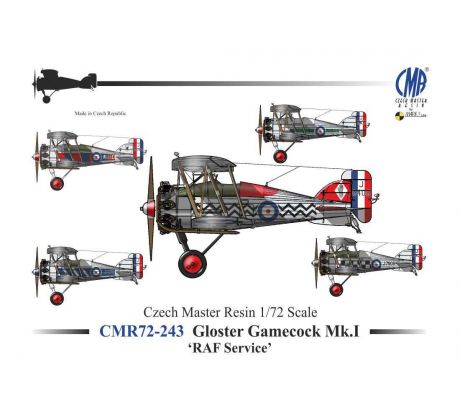Gloster Gamecock Mk.I ‘RAF Serviceʼ

Gloster Gamecock Mk.I ‘RAF Serviceʼ
This full resin kit contains 41 parts, clear windshield film and a comprehensive decal sheet.
This kit replaces the older model (CMR72-032), which has been cancelled.
Colour schemes included in the kit:
1) Gloster Gamecock Mk.I, J8084, No.23(F) Sq., flown by S/L R. Collishaw, RAF, Henlow airfield, Bedfordshire, 1927
2) Gloster Gamecock Mk.I, J8073, No.32(F) Sq., flown by Flg Off A.H. Montgomery, RAF, Kenley airfield, Croydon, 1927
3) Gloster Gamecock Mk.I, J7908, No.43(F) Sq., RAF, Tangmere airfield, West Sussex, 1926-27
4) Gloster Gamecock Mk.I, J8407, No.3(F) Sq., RAF, Upavon airfield, Wiltshire, 1927-28
5) Gloster Gamecock Mk.I, J8408, No.17(F) Sq., flown by S/L A.R. Arnold , RAF, Upavon airfield, Wiltshire, 1928
| Ref. No.: | CMR72-243 |
| Availability: | IN STOCK |
Gloster Gamecock Mk.I ‘RAF Serviceʼ
Description
The Gloster Gamecock was a British-built biplane fighter developed from the earlier Gloster Grebe Mk.III for the RAF service. The main change between the two types was the use of the Bristol Jupiter engine in place of the heavier Armstrong Siddeley Jaguar of the Grebe. The first of three Gamecock prototypes flew in February 1925, while deliveries commenced in May 1926, with a total of 90 Gamecock Mk.Is being procured.
The Gamecock was a single-seat interceptor of wooden construction with mixed metal, ply sheet and fabric covering. It was fitted with a fixed undercarriage and powered by a Jupiter VII radial engine turning two-blade wooden propeller. Its armament consisted of two machine guns in troughs in the fuselage side.
The Gloster Gamecock served with six operational RAF squadrons and No.2 & No.3 Training Schools. It was also used by the Central Flying School and the RAF College at Cranwell. Although the type was often praised for its manoeuvrability and speed, it suffered a high rate of accidents in service. The causes were remedied in the Gamecock Mk.II, of which only three were built; it had a revised wing construction, an improved pilot’s view and modified rudder and ailerons. A relatively brief flying career of the Gamecock Mk.I within the RAF ended in July 1931.
Last seen productsCancel history

Bell H-13J-2 (Brazil, Chile, Argentina)
Two injection-moulded kits from new moulds included in this box with clear parts (the cockpit canopy) for each model with 3 decal options.

Zeppelin LZ127 ‘Graf Zeppelin’
Mark I Models 1:720
This injection-moulded kit contains 46 parts, including a useful model stand. The kit length is 329mm (12.9in). A comprehensive instruction leaflet and a decal sheet are included.
Colour schemes included in the kit:
1) Zeppelin LZ127 ‘Graf Zeppelin’, D-LZ127, Black D, “First Flights 1928-29”. Operated by the German Airship Transportation Corp. (Deutsche Luftschifffahrts-Aktiengesellschaft, DELAG).
2) Zeppelin LZ127 ‘Graf Zeppelin’, D-LZ127, “Round-the-World Flight 1929”. Operated by DELAG.
3) Zeppelin LZ127 ‘Graf Zeppelin’, D-LZ127, “Propaganda and Commercial Flights 1933-36”. Operated by DELAG and (from March 1935) by the German Zeppelin Transport Company (Deutsche Zeppelin-Reederei, DZR).
4) Zeppelin LZ127 ‘Graf Zeppelin’, D-LZ127, “Last Flights 1936-37”. Operated by DZR.

AN/ALQ 131 3 band (deep version)
1/144 scale 3D resin printed AN/ALQ 131 3 band (Deep version). Include 2x pods. Fit Revell kit but should fit other kits too.








